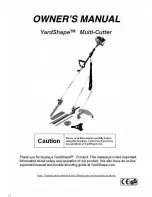
V1.0 2021 Copyright Safewaze
Page 5
•
Locking Speed:
The nature of this equipment requires sufficient space in the working area to allow for the SRL to lock. Working in small or
confined spaces may keep the user’s body from reaching the speed needed to lock the SRL during a fall. Working on slowly shifting
materials, such as grain or sand, may not allow the speed needed to cause the SRL to lock.
•
Swing Falls:
As the user moves laterally away from an overhead anchor point, the risks related to swing falls increase. The force of
striking an object involving swing fall can in some instances generate more forces than a fall with the user wearing no fall protection
equipment. Minimize swing falls by working as directly below the anchorage point as possible.
•
Free Fall:
Safewaze SRLs when used correctly with the unit anchored directly overhead and no slack in the lifeline, will limit the free fall
distance to 0 ft. (0 cm). In order to limit free fall distances, keep attachment of the SRL below Dorsal D-ring height to as minimal a
distance as possible. Safewaze Latitude Pro Arc Flash SRLs are designed for use up to a maximum of 2 ft. (.61 m) below the user’s Dorsal
D-ring.
•
Fall Clearance:
Figure 4 Illustrates a Fall Clearance Calculation. Fall Clearance (FC) is the total combined values of Free Fall (FF),
Deceleration Distance (DD), and a Safety Factor (SF). Safety Factor calculations may differ by manufacturer, but for the
purposes of this manual, the Safety Factor is calculated at 1.5 ft.. The Safety Factor includes D-ring shift and Harness Stretch.
Tables 6 in this manual indicates the Minimum Fall Clearance when the Latitude Pro Arc Flash are anchored overhead. Table 6 covers
users in the 130 lb to 310 lb range (Per ANSI).For falls from a kneeling or crouched position an additional 3 ft (1 m) of Fall Clearance is
required. If a Swing Fall Hazard exists, the total vertical fall distance will be greater than if the user had fallen directly under the
anchor point. Section 2.7 and Table 6 in this manual provide information regarding Swing Fall hazards and additional
Fall Clearance Requirements.
NOTE:
Special rescue measures may be required for a fall over an edge.
Type of Use
Application Examples
Conditions of Use
Inspection
Frequency
Competent Person
Infrequent to Light
Rescue and Confined Space,
Factory Maintenance
Good Storage Conditions, Indoor
or Infrequent Outdoor Use, Room
Temperature, Clean Environments
Annually
Moderate to Heavy
Transportation, Residential
Construction, Utilities, Warehouse
Fair Storage Conditions, Indoor and
Extended Outdoor Use, All Temperatures,
Clean or Dusty Environments
Semi-Annually to
Annually
Severe to Continuous
Commercial Construction, Oil and
Gas, Mining
Harsh Storage Conditions, Prolonged
or Continuous Outdoor Use, All
Temperatures, Dirty Environment
Quarterly to Semi-
Annually
TABLE 4 - INSPECTION SCHEDULE PER ANSI Z359.14
1.
Authorized Person:
A person assigned by the employer to perform duties at a location where such person will be exposed to a fall hazard.
2.
Rescuer:
Person or persons other than the rescue subject acting to perform an assisted rescue by operation of a rescue system.
•
Sharp Edges:
Safewaze Pro Arc Flash SRLs are not intended for use in a Leading Edge environment. User should avoid lifeline contact
with sharp, rough, or abrasive edges.
•
Hazards:
Extra precautions should be taken if this equipment is used in an environment where hazards exist. Hazards can include but are
not limited to: moving machinery, high voltage equipment or power lines, caustic chemicals, corrosive environments, toxic or explosive
gases, high heat, or in an area where overhead equipment or personnel could fall and contact the user, or fall protection equipment.
Areas where the user’s lifeline may cross or tangle with the lifeline of another user should be avoided. Do not allow the lifeline to pass
under arms or between the user’s legs.
Either the Authorized Person¹ (User) or the Rescuer² must inspect this equipment prior to each use. The Inspection table (Table 4), should be used to
determine proper inspection frequency. The Inspection Checklist (Page 16) illustrates proper inspection procedures. The Competent Person should
record inspection results in the Inspection Log (Page 17) of this manual. Annual inspections by a Competent Person other than the user must also be
recorded in the Inspection Log (Page 17).
2.0 INSPECTION FREQUENCY
When using this equipment, employers
must create and maintain a Fall Protection and Rescue Plan, and provide the means to implement those plans.
The plans must be communicated to equipment users, authorized persons, and rescuers. These plans must meet ANSI Z359.2 “Minimum Requirements
for a Comprehensive Managed Fall Protection Program.” They should include the requirements and guidelines for the employer’s managed Fall
Protection Program. This would include eliminating and controlling fall hazards, duties and training, policies, fall protection procedures, rescue
procedures, incident investigations, and evaluation of the programs effectiveness.
2.1 FALL PROTECTION & RESCUE PLAN




































